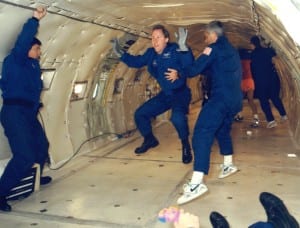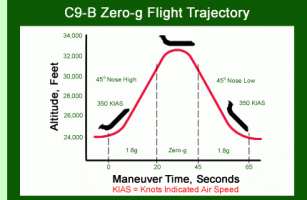UCF Students To Ride ‘Vomit Comet’
 Flying at zero gravity is usually something reserved for astronauts in training or very wealthy people with cash to burn, but six UCF students will get the chance to do so in June, courtesy of NASA.
Flying at zero gravity is usually something reserved for astronauts in training or very wealthy people with cash to burn, but six UCF students will get the chance to do so in June, courtesy of NASA.
NASA selected UCF’s team to run an experiment aboard a parabolic flight as part of its Undergraduate Student Instrumentation Program. Since getting the green light late last year, the team has been hard at work turning the project from concept to design to working prototype. The students have to meet a summer deadline in order to keep their slot on a specially designed plane that astronauts use to train. It’s often referred to as the vomit comet, because it is not for those with weak stomachs.
But these students aren’t nervous at all. It’s an amazing opportunity, especially for undergraduates, they say.
The experiment will study the sticking and gradual buildup of small particles onto a larger body in a vacuum and in microgravity to better understand particle interactions in protoplanetary disks and in planetary ring systems.
Or as Sara Lane, the only non-engineering or physics major on the team, put it: “We’re studying collisions in space environments that can’t easily be studied on earth. What we learn may be important in understanding how Saturn’s rings formed.”
Lane is the team’s scribe, specifically assigned to detail the team’s work and turn the science jargon into easy-to-understand language on a website dedicated to the project. (Follow the team’s journey at http://physics.cos.ucf.edu/cate/). She’s a marketing major and is in her third year of study. Her role was one of the aspects NASA particularly liked in UCF’s proposal, because the agency wants people to know what NASA does and why it matters.
Each member of the team brings a unique perspective and expertise.
Team members include:
Allyson Whitaker, an aerospace engineering major in her junior year. The Miami native was destined to be a writer until a high school science teacher interested her in science. From then on she was in love with science, and after arriving at UCF and working in the lab, she wanted to focus on planetary science. She is in charge of the materials that will be placed in the experiment and making sure they stay safe and secure and can execute as designed. After graduation she wants to work for a company designing rocket ships.
Kelly Lai, an aerospace engineering major in her senior year. The California native is the team leader and is helping with the design of one of the payloads in the experiment as well as the storage-rack structure of the experiment. After graduation she wants to work for a private aerospace company in its space development and exploration unit. She’s long been an advocate for space exploration, having lived in two of the four main states with a big NASA presence.
Christopher Tiller, a physics major in his third year. Tiller always envisioned himself creating video games, but in high school some “great teachers” exposed him to the world of physics. He aspires to attend graduate school and explore astrophysics.
Samuel Benjamin, a photonics sciences and engineering major in his junior year. He is working on making sure the experiment collects clean, reliable data and then helping interpret the data once the flight is over. While he hasn’t decided yet what he’ll specialize in after getting his degree, he’s leaning toward telescope instrumentation or laser engineering for augmented reality, such as products like Google Glass. The 19-year-old also is a gifted musician who played at the New York’s Carnegie Hall before enrolling at UCF.
Brad Hoover, an aerospace engineering major in his senior year. Hoover is in charge of turning the team’s computer-assisted designs into hardware. The Largo native said he dreams of flying in space someday and this project will give him a taste of that dream.
The team meets weekly to discuss designs, trial runs, project corrections and to make sure the members stay on track for meeting their deadline. The experiment must be complete and tested before the end of the semester in order to fly in June. The project will consist of testing how space dust interacts in zero gravity.
Several members of the team say Lane’s contributions go beyond communicating information to the general public.
“She has made useful suggestions about the design of the experiment that the engineers and scientists had not thought of,” Hoover said. “We have mentioned on multiple occasions that Sara should join us on the dark side and become a scientist.”
Lai sees an added benefit to having a non-scientist on the team.
“Helping her understand gets us ready for the industry world, since everyone we work with or encounter will not always be a technical person,” Lai said. “So coming up with different ways to explain has definitely helped all of us work on our communication skills.”
And that’s exactly what UCF professor Joshua Colwell hoped would happen. Colwell is faculty mentor, principal investigator for the project and the person who suggested a non-scientist be brought aboard. He and UCF scientist Adrienne Dove are helping the students by offering guidance and being a sounding board for ideas and frustrations. Colwell and Dove are both experienced parabolic fliers who will fly with the students during their four-flight campaign.
“This is a talented and motivated group of students,” Colwell said. “They are working well together and getting terrific hands-on experience in real-world space experimentation. I can’t wait to see it all come to fruition in June and watch their faces as they experience weightlessness for the first time.”
Read original story here.

